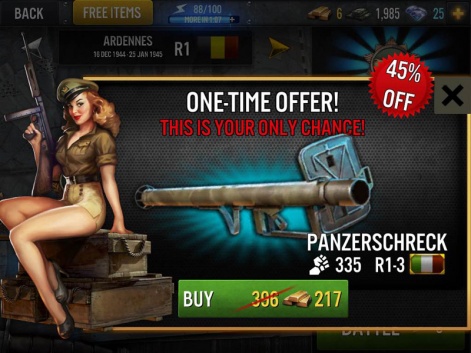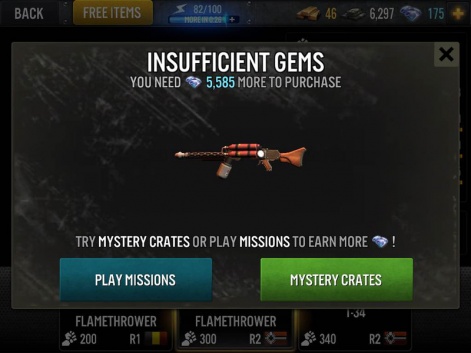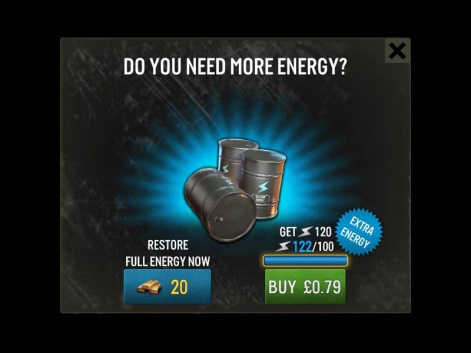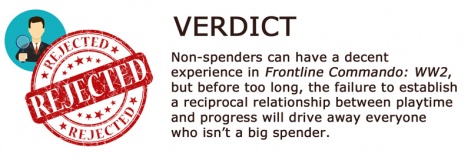Welcome back to the In-App Purchase Inspector- our regular look at free-to-play games from the consumer's perspective.
In each installment, we consider the incentives or pressure applied to make in-app purchases, their perceived value, the expansion offered by IAPs and the overall value of the experience.
The end goal is to see whether the game makes a good enough case for us to part with our cash, or whether players are content - or engaged enough - to freeload.
This time, we're taking a look at Glu Mobile's Frontline Commando: WW2, the latest in the thirdperson shooting series.
Guns blazing
Frontline Commando: WW2, like so many others on mobile, sensibly takes more design cues from the arcade than it does from PC and console.
Thus, with your character automatically moving between cover, what you're left with is a series of shooting galleries featuring targets of a Nazi persuasion. It's more 1940s Time Crisis than Call of Duty, one might say.
What it is, then, is an efficient set-up for framing short bursts of gun-toting action that come in various flavours. Machine guns, snipers, bazookas and flamethrowers are all well-represented here, giving the stages some semblance of variety.
More importantly, it also affords Glu Mobile the opportunity to sell new weapons as well as giving the option to upgrade your existing arsenal, which is the first prong of its strong monetisation push.

One mission may require your flamethrower to be of a certain standard, while another may necessitate the upgrade of a sniper rifle.
With this, Glu Mobile immediately establishes a pace of progress to which the player must adhere - not the other way around.
“Make wars unprofitable and you make them impossible”
The first thing to note is that Frontline Commando: WW2 features just about every established form of freemium monetisation.
Frontline Commando: WW2 features just about every established form of freemium monetisation.
With three currencies - one hard, one soft and one gained via progress - an energy system, incentivised video ads and an offer wall, one thing nobody could accuse it of is obfuscating its thirst for revenue.
The game's hard currency - gold, predictably - is a perfect example of this approach, making itself almost inaccessible through any method other than actually spending money.
When many developers are embracing reciprocity, this can be hard to get used to.
A problem symptomatic of this is that the incentivised video ads don't feel like they're providing enough incentive by any stretch - 30 seconds may not be a long time, but many will feel like it's wasted time regardless as they collect their paltry 1 gold reward.
The cost of gold's not cheap, either. Prices range from $4.99 for 100 to £99.99 for 6,500, with bulk-buyers getting far better value as you'd expect.

I opted to buy 480 gold at a price of £9.99 - more than I usually pay for games in this column - as I just didn't see 100 stretching far enough to make decent progress. However, as it turned out, 480 units of gold didn't last me very long either.
With a plethora of one-time offers on weapons, each promising some degree of astonishing exclusivity and value - “THIS IS YOUR ONLY CHANCE!” blares the on-screen message - then 480 gold really won't stretch very far.
On the frontline
But then, perhaps I'm just needlessly susceptible to these sort of tactics. After all, for the most part a sufficient level of upgrading can be achieved by using the game's soft currency, Warcash, which is handed out pretty liberally to reward completion of missions.
However, the more advanced upgrades predictably cost more Warcash - which can put more pressure on the player to buy them with hard currency instead. The wait timers get longer, too, increasingly provoking the player to skip them using gold.
Furthermore, there are some items - flamethrowers and tanks in particular - that cannot be purchased with soft currency, meaning they're effectively blocked off to non-payers.
For those players who are utterly determined to progress without paying, items can also be purchased using gems, the game's third currency that's even harder to come by.

Gems can occasionally be earned through mystery crates, which give the player a randomised freebie in return for some gold. However, winning gems in these crates is a rarity, and even if you do get lucky the number you win is ordinarily in the tens or low hundreds.
As a player, the game's stubbornness in terms of gifting currency makes me want to instinctively respond in kind.
The other way to earn gems is through playing special daily battles, which will yield better rewards based upon the number of consecutive days you play. But the quantity is small here, too.
Four consecutive daily battles will get you 35 gems, and after that you'll be rewarded with various tiers of free mystery crate. However, for some context, a fairly mid-tier flamethrower costs 5,760 gems, so that seems a route few will be patient enough to achieve.
Final hours
Another thing I found interesting to note, and a continuation of Glu Mobile's approach to free currency as something that should be hard-earned rather than simply given, is its offer of free gold to players who take up an offer from an offer wall provided by companies such as Tapjoy.
Be it a free trial of Now TV or a 30-percent-off voucher code for The Body Shop, you can earn up to 400 gold free of charge by signing up for each of these offers - perhaps a good deal for the keen player, but to my mind not worth the time spent unsubscribing from retailers' mailing lists.

There's also an energy system to contest with, although this only becomes a real pain when the difficulty ramps up.
Largely, this isn't an intrusive system - this series has tackled far worse - but it costing 20/100 to restart a failed mission is a kind of tax on incompetence when things get trickier.
Full energy can be restored with 20 gold or $0.99.
Ceasefire
There is certainly some fun to had for a non-paying player in Frontline Commando: WW2, but only up to a point.
As a player, the game's stubbornness in terms of gifting currency makes me want to instinctively respond in kind, by being tight-fisted and not investing financially.
Furthermore, after being convinced to spend money once, the yield was neither long-lasting nor impactful enough for me to want to do it again.






















